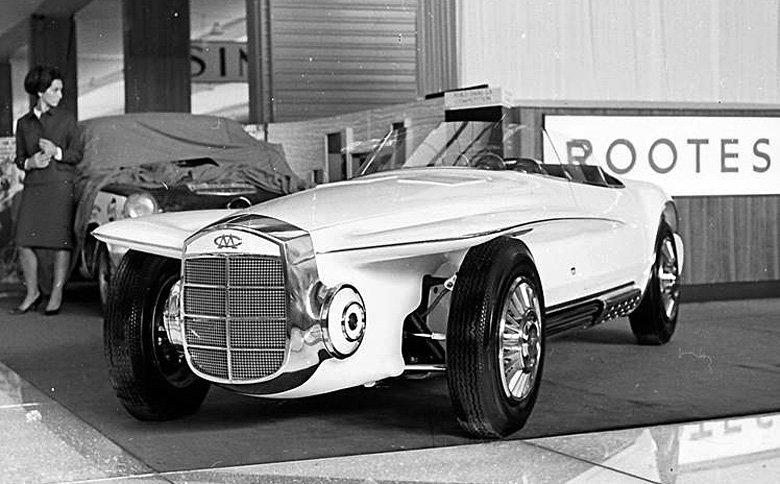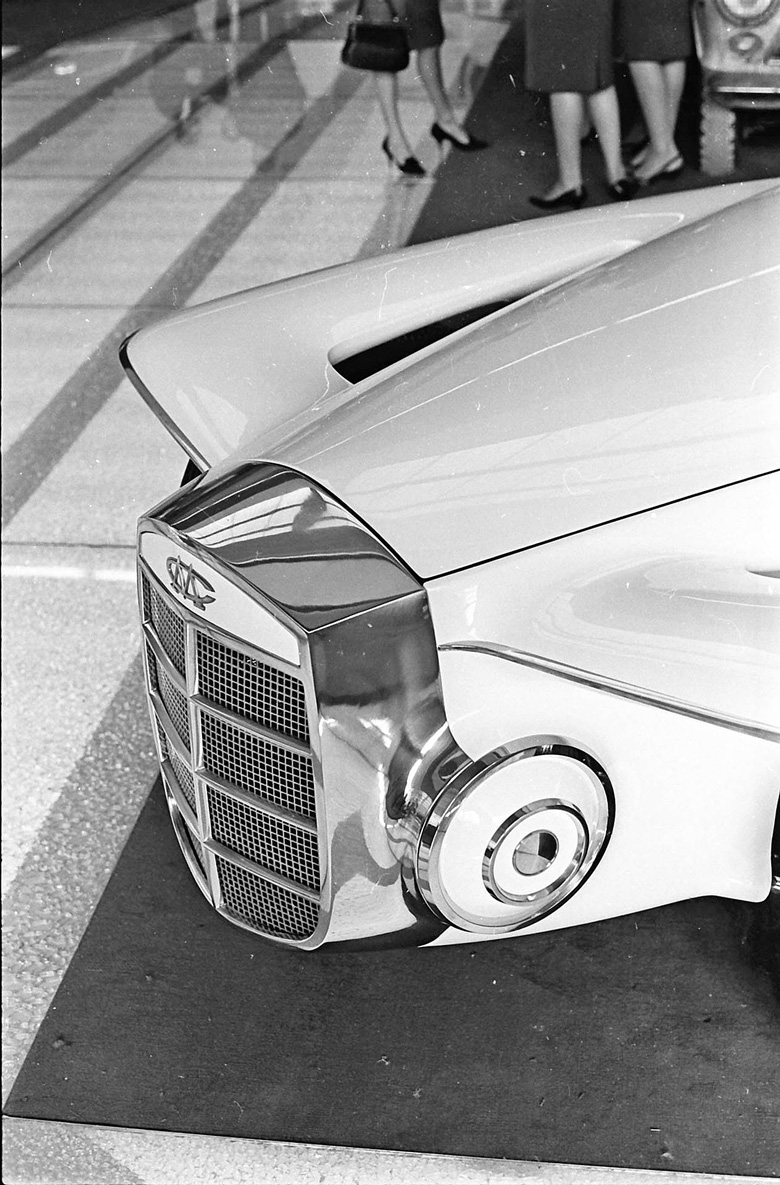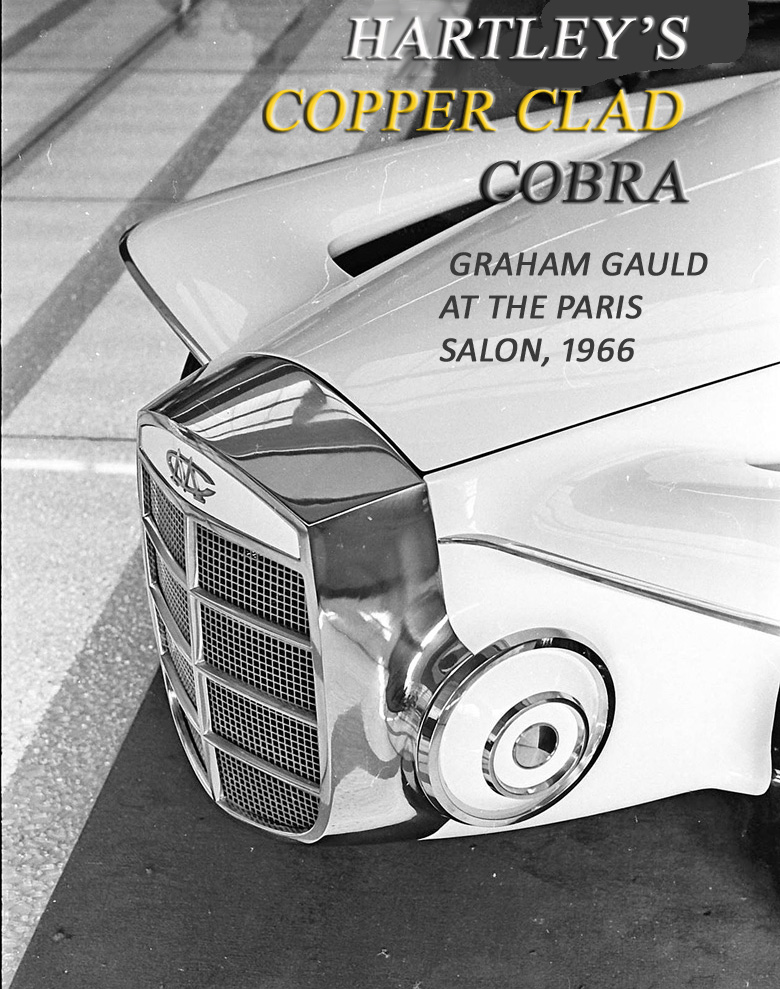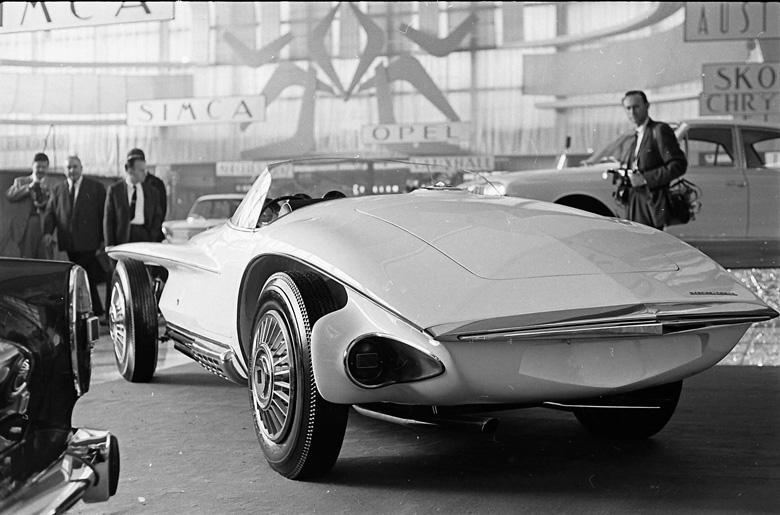Story and photos by Graham Gauld
Over the years I have attended scores of motor shows and seen many prototypes and oddities on display, some of which went on to have interesting histories and consequences.
Take, for example, the Mercer Cobra that halted me in my tracks at the 1966 Paris Automobile Salon because it looked different; very different indeed. However, it started ringing bells in the memory.
As an avid reader of Esquire and True magazine back in the 1950s and 60s, I always paid attention to the automobile stories, usually written by Diana Bartley or by Tony Hogg, later to become Editor of Road and Track.

The Mercer Cobra photographed more than sixty years ago on the stand at the Paris Auto Show. Note the MC stylized badge on the front.
In 1963 Diana came up with the brilliant idea of asking a noted automotive designer to come up with a modern take on four classic U.S. cars, the Stutz Bearcat, the Packard Convertible, the Duesenberg Sport Phaeton and the Mercer Raceabout. As he had just retired from the Chrysler Company after an illustrious career, she chose Virgil Exner, who was by then working with his son Virgil Jnr as an independent stylist.
These futuristic designs were then delivered to Esquire and published in their December 1963 issue. I remembered the article and I was not terribly impressed with the renderings but now, here I was in Paris in 1966 looking at the Mercer concept as a completed automobile; so how come?

The copper-faced radiator at the front and the copper-framed folding headlights as would befit a car commissioned by the Copper Development Association.
The U.S. automotive industry was on a high with new ideas not only in the mechanical side of development but in the materials used in cars. One such group was the Copper Development Association of America who wanted to push to have more copper used in automobile design. What better way than to take a design concept and make it into a show car that they could promote around the world?
The Copper Association’s President, George Hartley, was also an Esquire reader, remembered the Exner designs and approached him about turning his design into metal, and in particular to utilize as much copper as possible.
As Exner had worked closely with Luigi Segre of Ghia until Serge’s death in 1963, it was expected he would use Ghia, but instead he chose Sibona-Basano, a lesser known Carrozzeria in Turin, to create the car. Pietro Sibona was a skilled metal stylist who had worked for Ghia and had just joined the Basano brothers who were already building some of the bodies for the sports Abarths of the early 1960s.
As for a chassis, Carroll Shelby was the U.S. importer of the British AC sports cars and after Shelby had done a deal with Ford Motor Company to supply the new Ford V8 engines, AC built the first prototype and then sold rolling chassis suitable for the V8 to Shelby. This led to Shelby’s manufacturing his own Shelby-Cobras. For the Mercer-Cobra, a chassis was sent from England to Sibona-Basano in Italy to start creating the concept car: for the record it was chassis CSX2451.
I can just imagine the scene in Turin when the Copper Development Association’s materials specification arrived at the coachbuilders. For a start they wanted to promote copper and brass and eleven different finishes and alloys were used in the car. Obviously they started out with a brass radiator grille which, like many of the other elements, was coated with an acrylic coating to hinder discoloration. Brass was also used on the unique swinging headlights, the engine valve covers and the air cleaner. The side exhausts were chrome plated but a silicon bronze heat shield was added to save the driver and passenger having braised legs. Even the brake discs were made from a copper alloy which helped them to cool quicker.
What made the whole ensemble so stunning was the finish of the car which was in pearl white with a black interior and sporting a full width plexiglass windscreen.
Some idea of the scale of the project was that from concept to finished car cost the Copper Development Association some $35,000 in late 1964. However, they did market and promote it well and the car was shown all over the world.
Did it create a marked change in the use of their products in normal production cars? Perhaps, but not significantly.
After its trips around the world the car was kept at the CDA headquarters for nearly ten years before being sold to Joe Bortz who has his unique motor museum for show cars in Highland Park, Ill. It was later sold and finally came up for auction by RM Auctions at Monterey in 2011 where it fetched $660,000.


Typo error,
It is Luigi Segre of Ghia…not Serge.
Pls delete previous message
Always great to read Graham. For the record, it should be Luigi Segre, not Serge. Happy Holidays all!
Typo corrected, thanks!
Ed.
Thanks for this interesting story. The Copper Development Association funded a number of prototype cars. It would be interesting to learn more about some of the others. For example, Triad Services in the Detroit area designed and built an electric car for them around 1975. There are some blurry pictures and a short description here (page down to “C”) http://boursinp.free.fr/velec/1975.htm This page says it is the fourth car funded by CDA.
Triad included former Chevy and Chaparral engineer Mike Pocobello, they wrote an SAE paper about the car, abstract here http://papers.sae.org/760071/ Pretty good to eke out a 100 mile range from lead acid batteries…about 20 years before the GM/Aerovironment EV-1.
Written as only raconteur Graham Gauld can tell a story. The Mercer Cobra’s a bit bizarre for my taste but what an interesting piece of automotive history. Thanks, Graham, for enlightening us…
My father was an Air Force pilot stationed in Europe 1960-1964. I attended the Paris Auto Show with him (thanks Dad!) in 1964. This Mercer Cobra was there, along with the Ford GT and real Cobras. Thanks for the story, I had no idea what it was all these years. I still have a photo of the Mercer.
I was able to see the Cobras and Ford GTs race at the Nurburgring and Spa … great memories!
Graham
Great piece of history. The Mercer Cobra was here at Blackhawk for a number of years when the Museum first opened and it was displayed in the lobby atrium paired with the Exner designed Bugatti 101, which made for a quite a welcome!
Always enjoy reading your work.
Merry Christmas…
Tim